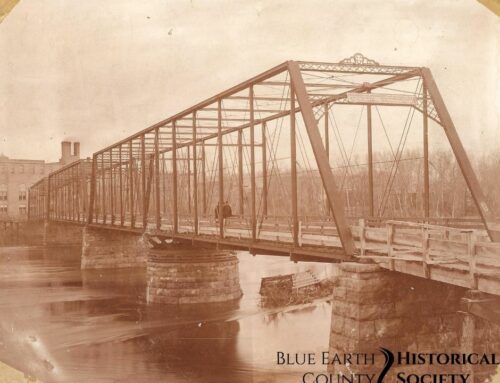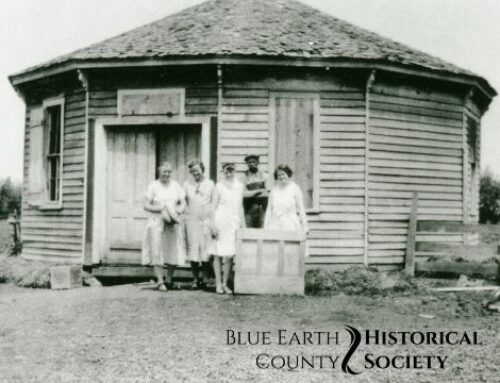In 1854, Basil Moreland rounded a bend in the Blue Earth River and staked a claim on the land at the top of the east bank. Aware that the land was part of the Winnebago Indian Reservation, but recognizing the potential water power available at the falls, Moreland built a house. However, others, and Moreland, were soon evicted by the government and settlers were barred from settling in the area until 1863, when the government removed the Winnebago Indians from the area and opened the area for settling.
In 1858, a county board named the township location as “DeSoto”, but in 1864, a man by the name of C.P. Cook renamed the township Rapidan. The origins of the name Rapidan are ambiguous, but the most commonly accepted origin is that Cook named the town after a river in Pennsylvania. In 1865, a bill passed by the state legislature made the name change official and the township was officially organized in April 1865. On April 15th of that year, the first town meeting was held at the home of E.C. Payne.
Between 1865 and 1867, the first sawmill was built, as well as the post office, named “Maple River”, and run by postmaster Lucius Dyer. A new post office was built in 1876 at the home of Olaf Olson and was named Rapidan. The sawmill was added on to later, adding a flour mill which came to be known as “Union Mill”. At the home of J.D. Hooser, the first religious services were held in 1864, led by United Brethren Minister Steinner of Alma City. Later, after being held in a log school house, church services were held in the newly-constructed church building, erected in 1885. The first school house was built in 1866 and the first classes were taught by Miss Emma Smith of Garden City. The co-op creamery built in 1897 delivered its first milk on Oct. 11, 1898.
The sawmill established in 1866 was a major draw to settlers, by the 1870s, the mill was thriving, turning out 50 barrels of flour in just 24 hours. This flour was then traded by farmers, who came from all over the region, to trade wheat. The next decade of progress at the mill saw more efficient and sophisticated improvements made to the mill, such as blasting an 800 ft. long tunnel through the rock, diverting water, and taking advantage of the 21-foot drop of the falls. Doing this allowed the more efficient transfer of power, and led to speculation about transmitting the surplus power to neighboring towns like Mankato. However, due to the impracticality and the expense of transmitting power to Mankato or Lake Crystal, it was instead decided that the manufacturing plants be developed, and the capacity of the flour mill be enlarged. In addition, a linseed oil mill and grain elevator were built, to further streamline the processes of the plant.
In 1892, disaster struck, and a fire caused huge damage to the equipment and products at the oil mill. Due to this, power was not used commercially again until 1899, when the site of the defunct mill was bought by Thomas Rodgers, who built a modern 3-story flour mill. Between 1899 and 1910, productivity improved to the point of grinding out 50-75 barrels of flour a day.
In 1910, Rodgers sold his mill to Consumer’s Power Company, which later became the Northern States Power Company. Later that year, a hydroelectric dam was built on the Blue Earth River, with the initial output of power doubling the capacity of Mankato’s electric system. The construction of the dam required many workers, several of whom were immigrants who took the train from Mankato every day. As an important source of electric power for the Mankato area, the dam also represented the progressive construction methods of using hollow reinforced concrete to increase the dam’s durability.
In 1970, Northern States Power Company presented the dam and the 750 acres to Blue Earth County, as an environmental corridor of wildlife habitats, recreation areas, and nature trails. In 1972, because of the high-hazard structure of the dam, which would cause considerable damage to the surrounding areas upon collapse, the Blue Earth County board ruled that the dam should either be rebuilt or torn down. In 1980, after the Windfall Tax Act and the Public Utilities Regulatory Policies Act of 1978 were passed, the hydro market was revived, and Rapidan dam was one of the first hydroelectric facilities to be renovated with public and private sector cooperation. More concrete reinforcement was added to the dam in the re-build, to account for safety concerns, and in 1985, the National Society of Professional Engineers named the Rapidan dam renovations as one of the top engineering feats of 1986.
In 1970, instead of holding the traditional Fourth of July celebrations held all over the county, Rapidan voted to celebrate four days earlier and call the new celebration Rapidan Dam Days, allowing for more guests to pour in from the surrounding areas, and becoming the area’s largest fireworks display. A parade, band, concessions, and many games make it still a well-attended event in Rapidan. In 1976, the citizens of Rapidan fought hard for the town’s first “urban renewal project”, which repaved and widened the town’s main street, as well as adding curbs and gutters. With the completion of the project, citizens felt the image of their town had improved by 100% and that it would help the appearance of the village’s tiny downtown. In 1993, teacher Dave Schultz, and his father, professor and optometrist Sherman Schultz, built an observatory behind Dave’s property in Rapidan, naming it Alfafa Centauri. The observatory, featuring a motorized roll-off roof and housing two telescopes and a 36-inch camera, will be available for use by area students in order to increase youth interest in astronomy, as well as host astronomy-themed essay contests. The Rapidan Dam Store has become a staple of the community, with its locally renowned pie, and many events take place in this small town, such as the River Ramble, a 42-mile bicycle ride participated in by almost 1500 people the year after its 2011 conception.
In the last half of the century, Rapidan grew into a bedroom community of Mankato, with its 1973 reported population to be 200, and the 2010 population as 1,101. Since then, Rapidan has distinguished itself as a village with a deep sense of identity and well-preserved history.





Leave A Comment